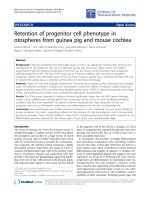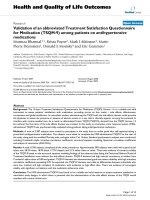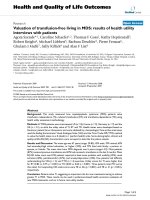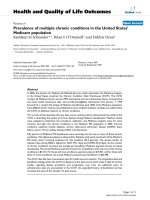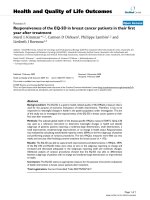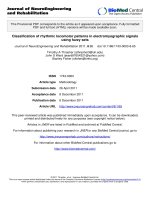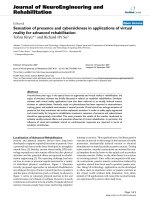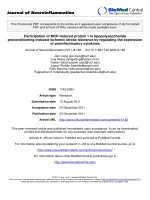báo cáo hóa học: " Value of high-sensitivity C-reactive protein in low risk chest pain observation unit patients" doc
Bạn đang xem bản rút gọn của tài liệu. Xem và tải ngay bản đầy đủ của tài liệu tại đây (214.18 KB, 5 trang )
ORIGINAL RESEARCH Open Access
Value of high-sensitivity C-reactive protein in low
risk chest pain observation unit patients
Deborah B Diercks
1*
, J Douglas Kirk
1
, Seif Naser
1
, Samuel Turnipseed
1
and Ezra A Amsterdam
2
Abstract
Objective: High-sensitivity C-reactive protein (hs-CRP) rises with cardiac injury/ischemia. We evaluated its efficacy in
aiding in the identification of an acute coronary syndrome (ACS) in patients (pts) admitted to the chest pain unit
(CPU) for possible ACS.
Methods: Retrospective study of all patients admitted to the CPU with chest pain who underwent hs-CRP testing
as part of their CPU evaluation from January 2004 to October 2008. Patients were low risk for ACS (compatible
symptoms, nondiagnostic initial ECG, and negative cTnI). ACS was diagnosed by positive functional study, cardiac
catheterization, or cardiac ev ent during 30-day follow-up. Positive hs-CRP was defined based on local laboratory
levels (>1.0 mg/l or >3.0 mg/l), and population-based and prior study values >2.0 mg/l. Chi-square analysis was
performed, and odds ratios (OR) are presented. Multivariate analysis was done to determine whether hs-CRP was
independently associated with the diagnosis of ACS. Cardiac ris k factors, demographics, and diagnosis of ACS were
included in the model. Medians with IQR are presented for continuous data. Ninety-five percent confidence
intervals are presented where applicable.
Results: A total of 958 patients had hs-CRP testing as part of their CPEU evaluation. Excluded from the analysis
were 39 patients lost to follow-up. The final cohort comprised 478 (52%) women and 441 (48%) men with a
median age of 56 (IQR 48-64). ACS was diagnosed in 128 (13.4%). The median cohort hs-CRP value was 2.2 mg/l
(IQR 0.7, 5.8) and 2.3 mg/l (IQR 0.6, 5.9) in those with and without ACS, respectively. In the multivariate analysis
hs-CRP was not independently associated with the diagnosis of ACS (0.99; 95% CI 0.98 - 1.01).
Conclusion: In large patient cohort managed in a single-center CPU, measurement of hs-CRP did not enhance the
diagnostic accuracy for ACS. Routine hs-CRP as a diagnostic tool should not be recommended in the CPU setting.
Introduction
The management of patients presenting to the emer-
gency department (ED) with chest pain is a continuing
challenge. Of primary concern is recognition or exclu-
sion of an acute coronary syndrome (ACS), which is
initiated with risk stratification that encompasses a pro-
tocol-driven approach that begins with the patient’shis-
tory, physical examination, and electrocardiogram,
(ECG) [1]. This method provides early evidence of the
presence or abse nce of myocardial ischemia/injury. In
those patients with negative findings, which indicate low
or moderate clinical risk depending on individual clini-
cal characteristics, normal cardiac injury markers further
reduce the probability of ACS and subsequent adverse
clinical events. The injury markers currently utilized are
the cardiac troponins, the myocardial band (MB) of
creatinine kinase, and myoglobin. The findings of nor-
mal confirmatory evaluation such as a tr eadmill stress
test in addition to this negative initial evaluation identi-
fies a group of patients that can be safely discharged
from the ED with early follow-up [1].
Numerous biomarkers have been investigated for the
rule in the pathophysiology of ACS, including markers
of inflammat ion [2,3]. Acute inflammation is an impor-
tant factor in ACS through its role in coronary plaque
disruption and other aspects of the pathophysiology of
this syndrome. The association of inflammation wit h
ACS is reflected by an increase in multiple inflammatory
markers that can be de tected as acute phase reactants.
High-sensitivity C-reactive protein (hs-CRP) is a
* Correspondence:
1
Department of Emergency Medicine, University of California, Davis Medical
Center, Sacramento, CA, USA
Full list of author information is available at the end of the article
Diercks et al. International Journal of Emergency Medicine 2011, 4:37
/>© 2011 Diercks et al; licensee Springer. This is an Open Access article distri buted under the terms of the Creative Commons Attribution
License ( which permits unrestricted use, distribution, and reproduction in any medium,
provided the original work is pro perly cited.
non-specific marker of inflammation that has been
shown to have prognostic significance in patients with
coronary artery disease [4,5]. This property has led to
the evaluation of hs-CRP as a diagnostic tool in patients
presenting to the ED with chest pain, and the diagnostic
utility of hs-CRP in this setting has been variable
depending on the patient populations studied [6-9]. In
this investigation we evaluated the diagnostic accuracy
of hs-CRP in low risk patients evaluated for ACS in our
chest pain unit (CPU) in order to determine whether
this marker can aid in the discrimination of those with
and without ACS.
Methods
This is a secondary analysis of prospective data from a
single urban tertiary medical c enter CPU from 1 April
2004 to 31 October 2008. The study was approved by
our institutional review board.
Patient population
Inclusion criteria
All patients w ith a chief complaint of chest pain or an
anginal equivalent referred to our CPU were eligible for
this study. Our CPU accepts patients who have been
evaluated by the ED physician for suspicion of ACS, but
are considered low risk based on a normal cardiac injury
marker profile and a normal, non-diagnostic, or
abnormal but unchanged ECG [10]. Depending on the
individual patient risk, patients are further risk stratified
by a variety of metho ds that include obtaining serial
ECGs and cardiac injury markers, and performance of
confirmatory testi ng, such as stress electrocardiography,
myocardial perfusion i maging, stress a ngiography, and
coronary angiography. Serum hs-CRP was ordered in
these patients at the discretion of the CPU physician.
Only those patients who underwent hs-CRP testing
were included in this analysis.
High-sensitivity C-reactive protein
We utilized hs-CRP by Beckman SYNCHRON LX. The
manufacturer’s threshold for an abnormal value inter-
mediate for cardiovascular events was 1.0 mg/l to 3.0
mg/l and high risk >3.0 mg/l.
Outcome measure
The outcome measure of ACS was defined by ischemia
on ECG cardiac marker elevation, or an abnormal con-
firmatory test indicating the presence of coronary artery
disease (CAD). Lack of ACS was determined by negative
diagnostic testing or absence of a cardiac event (death,
myocardial infarction, or revascularization) during the
30-day follow-up period. Patients lost to follow-up and/
or who did not undergo a diagnostic test were excluded
from the analysis.
Statistical analysis
Hs-CRP threshold
We evaluated the thresholds for intermediate risk and
high risk based on manufacturer recommendations. The
dichotomous threshold for hs-CRP was created using
the ROC curve. We also evaluated the hs-CRP threshold
≥2.0 mg/l based on a recent large clinical trial [11].
Continuous data were assessed for normality, and
median interquartile ranges are presented. Measures of
associat ion were per formed (odds ratio) and diagnostic
test characteristics determined. Sensitivity, specificity,
and likelihood ratios were calculated and 95%
confidence intervals (CI) presented for local laboratory
hs-CRP thresholds as defined above, population thresh-
old defined by the ROC curve, and the value used in
clinical trials.
Logistic regression was performed to determine if
hs-CRP was independently associ ated with the diagnosis
of ACS. Covariates associated with the diagnosis of ACS
were entered into the regression analysis (age, gender,
cocaine or methamphetam ine use, past medical history
of diabetes, hypertension, hypercholesterolemia, f amily
history of myocardial infarction, tobacco use, prior
history of CAD, and a normal electrocardiogram).
Hs-CRP was evaluated as a continuous variable
(Table 1). All analyses were performed on Stata 9.0,
(College Station, TX).
Results
A total of 958/3,173(30.2%) patients had hs-CRP testing
as part of their CPU evaluation. Of these 958 patients,
40 (4.1%) were lost to follow-up and therefore excluded
from the study. The final cohort comprised 918 patients,
including 4 78 (52%) women and 441 (48%) men with a
median age of 56 years (IQR 48-64 years). Demogra phic
data are presented in Table 2. Confirmatory testing
Table 1 Regression analysis for the association of hs-CRP
with the diagnosis of acute coronary syndrome
Variable Adjusted OR (95% CI)
Age (year) 1.03 (1.01-1.05)
Male gender 1.71 (1.12-2.61)
Prior CAD 2.80 (1.77-4.41)
Family history of CAD 1.33 (0.86-2.08)
Hypertension 1.34 (0.78-2.33)
Cholesterol 1.68 (1.03-2.78)
Diabetes mellitus 0.97 (0.62-1.51)
Tobacco 1.43 (0.92-2.24)
Cocaine 0.59 (0.16-2.15)
Amphetamine 2.2 (0.79-6.32)
Normal ECG 0.71 (0.47-1.07)
hs-CRP mg/l 0.99 (0.98-1.01)
CAD, coronary artery disease; ECG, electrocardiogram; hs-CRP, high sensitivity
C reactive protein
Diercks et al. International Journal of Emergency Medicine 2011, 4:37
/>Page 2 of 5
methods used to diagnose ACS included: stress electrocar-
diography (n = 327), myocardial perfusion scintigraphy
(n = 251 stress, n = 59 rest), stress echocardiography
(n = 83), and coronary angiography (n = 178). The final
outcome of ACS was diagnosed in 128 (13.4%).
The median cohort hs-CRP value was 2.2 mg/l (IQR
0.7, 5.8) and 2.3 mg/l (IQR 0.6, 5.9) in those w ith and
without ACS, respectively (Figure 1). Based on the
population-based ROC curve, no threshold fo r hs-CRP
to predict the diagnosis of ACS could be defined
(Figure 2). Using a threshold defined in prior clinical
trials, an elevated hs-CRP had a sensitivity, specificity,
positive likelihood ratio, and negative likelihood ratio for
ACS of 53.1%, 50.3%, 1.05, and 0.99, respectively. In
addition, measures of diagnostic accuracy are presented
for all studied thresholds in Table 3.
The 40 patients who were excluded from the study
becausetheywerelosttofollow-updifferedslightly
from the overall cohort. These patients had a lower pre-
valence of both hyperte nsion and elevated c holesterol
than the study cohort.
Discussion
In this study of low-moderate risk patients admitted to
our CPU who underwent hs-CRP testing, we found little
diagnostic utility for detection of ACS as defined by a
positive confirmatory study or subsequent adverse
cardiac event during a limited post-discharge interval.
This study adds to the limited information on hs-CRP
as a diagnostic tool in patients presenting to the ED
with chest pain.
The initial evaluation of CRP in the setting of acute
evaluation, did not utilize a high-sensitivity assay. Prior
studies evaluating the use of CRP in the acute setting
vary with the risk of disease, length of follow-up, and
type of CRP t esting utilized. Magadle et al. measured
Table 2 Patient demographic data and factors associated
withdiagnosis of ACS
Variable ACS, No ACS,
N = 128 (%) N = 790 (%)
Age (years) (mean; SD) (56.2; 12.0) (61.4; 12.2)
Male gender 78 (60.9) 362 (45.8)
Prior disease 60 (46.8) 119 (15.0)
Family history of CAD 42 (32.8) 232 (29.3)
Hypertension 106 (82.8) 525 (66.4)
Cholesterol 98 (76.5) 412 (52.1)
Diabetes mellitus 43 (33.6) 228 (28.8)
Tobacco 53 (41.4) 268 (33.9)
Cocaine 4 (3.1) 30 (3.8)
Amphetamine 7 (5.4) 21 (2.6)
Normal ECG 52 (40.6) 456 (57.7)
ACS, acute coronary syndrome; SD, standard deviation; CAD, coronary artery
disease; ECG, electrocardiogram
0 50 100 150
hsCRP
No ACS
ACS
Figure 1 hs-CRP values in presence of acute coronary syndrome.
Diercks et al. International Journal of Emergency Medicine 2011, 4:37
/>Page 3 of 5
CRP levels in 226 patients referred to the ED with
chest pain who were followed for 1 year and in whom
the outcome measure was occurrence of coronary
events. Based on a diagnostic threshold for CRP of 25
mg/l, sensitivity for the diagnosis o f ACS was 93%,
specificity 65%, and negative predictive value 96% [8].
This study excluded 100 patients because of medical
conditions other than CAD that may elevate CRP.
Mitchell et al. evaluated a convenience sample of 414
patients admitted to a CPU in whom the prevalence of
ACS was 1.7%. Utili zing a multi-marker panel, they
found that the negative likelihood ratio for CRP was
0.79 (95% CI 0.4-1.01) [6]. Liyan et al. evaluated 113
patients presenting to the ED within 12 h of chest pain
onset. Ninety patients had a final diagnosis of ACS
[11]. Using a population-based threshold for CRP of
≥3.16, the sensitivity for diagnosis of ACS was 70%
and specificity 74% [12]. Despite the differences in the
study populations, the relatively consistent negative
results of the foregoing studies suggest the diagnostic
accuracy of CRP adds little to the assessment of these
patients.
Our study evaluated the use of a contemporary
hs-CRP at a single point in time. Loz ona et al. evaluated
a subgroup of 191 ED patients with an inconclusive
caus e of chest pain and determined the diagnostic value
of a change in two measurements of hs-CRP. In the
cohort of 191 patients, 38 had a diagnosis of ACS. All
patients completed a CPU protocol with functional test-
ing or coronary angiography. There was no difference in
the initial hs-CRP values between the groups of patients
with and without CAD [7]. However, in those patients
with an increase in hs-CRP from presentation to 24 h
later, the sensitivity, specificity, likelihood ratio (LR)+,
and LR- for the dia gnosis of ACS were 95 (95% CI 81,
98), 40% (95% CI, 32, 47), 1.57 (95% CI, 1.33, 1.83), and
0.13 (95% CI 0.04, 0.44), respectively [7]. This study sug-
gests that changes in hs-CRP may be more reflective of
an acute coronary process, although the specificity was
unsatisfactory.
Limitations
This study is a retrospective analysis of existing clinical
data. Our CPU protocol does not mandate that all
0.00 0.25 0.50 0.75 1.00
Sensitivity
0.00 0.25 0.50 0.75 1.00
1 - Specificity
Area under ROC curve = 0.4969
Figure 2 ROC curve for the diagnostic accuracy of hs-CRP.
Table 3 Measures of diagnostic accuracy for the diagnosis of acute coronary syndrome
Hs-CRP thresholds Sensitivity Specificity Likelihood ratio positive Likelihood ratio negative
≥1.0 mg/l 68% (59.1%-75.9%) 32% (28.9%-35.3%) 1.00 (0.88-1.14) 0.99 (0.76-1.31)
>3.0 mg/l 43.8% (35.2%-52.8%) 58.5% (55.0%-61.9%) 1.05 (0.85-1.3) 0.96 (0.81-1.13)
≥2.0 mg/l 53.1% (49.6%-67.7%) 50.3% (46.8%-53.9%) 1.05 (0.76-1.45) 0.99 (0.94-1.04)
Diercks et al. International Journal of Emergency Medicine 2011, 4:37
/>Page 4 of 5
patients undergo confir matory diagnostic testing. There-
fore, not all patients had diagnostic tests for CAD per-
formed, and this may have underestimated the true
incidence of ACS in our patient population. Patients
admitted to our CPU have risk factors for coronary
artery disease, such as diabetes, and therefore this popu-
lation may have increased CRP values when compared
to a patient population that lacks these risk factors for
cardiac disease. Although hs-CRP is on our standard
order form f or the CPU, not all patients underwent hs-
CRP testing, which could have resulted in selection bias.
Physicians were not blinded to the results of the hs-CRP
value, and it is possible that medications with potential
anti-inflammatory actions, such as statins, may have
been initiated as a result of a high value, which could
have altered the risk of subsequent cardiac events within
the 30-day follow-up period. In addition, we e valuated
hs-CRP only in the context of its diagnostic value for
ACS. It is possible that the true value of hs-CRP may be
related to mortality or identific ation of an alternative
diagnosis as prior studies have shown that hs-CRP has
prognostic value [11].
Conclusion
In our large patient cohort, managed at a single-center
CPU, measurement of hs-CRP did not enhance the diag-
nostic accuracy for detecting ACS. Based on our study,
we do not recommend routine measu rement of hs-CRP
as a diagnostic tool in this patient population.
Author details
1
Department of Emergency Medicine, University of California, Davis Medical
Center, Sacramento, CA, USA
2
Division of Cardiology, University of California,
Davis Medical Center, Sacramento, CA, USA
Authors’ contributions
DD drafted the initial chapter. Both DD and BM edited and contributed to
the final content of the review article.
Competing interests
Deborah B. Diercks: Consultant: Sanofi Aventis, Daiichi Sankyo, Abbott
Vascular Institutional Research Support: Beckman Coultier, Nanosphere, Board
of Directors: Society of Chest Pain Centers and Providers
Bryn Mumma: No competing interests
Received: 26 December 2010 Accepted: 24 June 2011
Published: 24 June 2011
References
1. Amsterdam EA, Kirk JD, Bluemke DA, Diercks D, Farkouh ME, Garvey JL,
Kontos MC, McCord J, Miller TD, Morise A, Newby LK, Ruberg FL, Scordo KA,
THompson PD: Testing of Low-Risk Patients Presenting to the
Emergency Department With Chest Pain. A Scientific Statement From
the American Heart Association. Circulation 2010, 122:1756-76.
2. Correia LC, Andrade BB, Borges VM, Clarencio J, Bittencourt AP, Freitas R,
Souza AC, Almeisa MC, Leal J, Estever JP, Barral-Netto M: Prognostic value
of cytokines and chemokines in addition to the GRACE Score in non-ST-
elevation acute coronary syndromes. Clin Chim Acta 2010, 411:540-5.
3. Burazor I, Vojdani A, Burazor M: Interrelationship of interleukin 6, C-
reactive protein and Chlamydia pneumoniae IgG antibodies in patients
with acute coronary syndromes. Vojnosanit Pregl 2008, 65:425-33.
4. Zairis MN, Adamopoulou EN, Manousakis SJ, Lytas AG, Bibis GP,
Ampartizidou OS, Apostolatos CS, Anastassiadia FA, Hatzisavvas JJ,
Argyrakis SK, Foussas SG: The impact of hs C-reactive protein and other
inflammatory biomarkers on long-term cardiovascular mortality in
patients with acute coronary syndromes. Atherosclerosis 2007,
194:397-402.
5. Nakachi T, Kosuge M, Hibi K, Ebina T, Hashiba K, Mitsuhashi T, Endo M,
Umemura S, Kimura K: C-reactive protein elevation and rapid
angiographic progression of nonculprit lesion in patients with non-ST-
segment elevation acute coronary syndrome. Circ J 2008, 72:1953-9.
6. Mitchell AM, Garvey JL, Kline JA: Multimarker panel to rule out acute
coronary syndromes in low-risk patients. Acad Emerg Med 2006, 13:803-6.
7. Lozano T, Ena J, Almenar V, Graells M, Molina J, Antorrena I, de la Guia F:
[Evaluation of patients with acute chest pain of uncertain origin by
means of serial measurement of high-sensitivity C-reactive protein]. Rev
Esp Cardiol 2007, 60:817-24.
8. Magadle R, Weiner P, Beckerman M, Berar-Yanay N: C-reactive protein as a
marker for active coronary artery disease in patients with chest pain in
the emergency room. Clin Cardiol 2002, 25:456-60.
9. Potsch AA, Siqueira Filho AG, Tura BR, Gamarski R, Bassan R, Noqueira MV,
Moutinho MA, Silva AC, Villacorta H, campos AL: C-reactive protein
diagnostic and prognostic value in patients presenting at the
emergency room with chest pain. Arq Bras Cardiol 2006, 87:275-80.
10. Kirk JD, Diercks DB, Turnipseed SD, Amsterdam EA: Evaluation of chest
pain suspicious for acute coronary syndrome: use of an accelerated
diagnostic protocol in a chest pain evaluation unit. Am J Cardiol 2000,
85:40B-48B, discussion 49B.
11. Ridker PM, MacFayden J, Libby P, Glynn RJ: Relation of baseline high-
sensitivity C-reactive protein level to cardiovascular outcomes with
rosuvastatin in the Justification for Use of statins in Prevention; an
Intervention Trial Evaluating Rosuvastatin (Jupiter). Am J Cardiol 2010,
106:204-9.
12. Liyan C, Jie Z, Yonghua W, Xiaozhou H: Assay of ischemia-modified
albumin and C-reactive protein for early diagnosis of acute coronary
syndromes. J Clin Lab Anal 2008, 22:45-9.
doi:10.1186/1865-1380-4-37
Cite this article as: Diercks et al.: Value of high-sensitivity C-reactive
protein in low risk chest pain observation unit patients. International
Journal of Emergency Medicine 2011 4:37.
Submit your manuscript to a
journal and benefi t from:
7 Convenient online submission
7 Rigorous peer review
7 Immediate publication on acceptance
7 Open access: articles freely available online
7 High visibility within the fi eld
7 Retaining the copyright to your article
Submit your next manuscript at 7 springeropen.com
Diercks et al. International Journal of Emergency Medicine 2011, 4:37
/>Page 5 of 5
